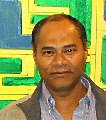 Bivas Chaudhuri is an award-winning artist who was born in India. He was always fascinated by all forms of art especially three dimensional image making. He received his MFA from Brooklyn College after coming to the United States in the 1980s. His bicultural background and knowledge add a rich mosaic of ideas to his creative work. His work has been featured in Art News, Queens Chronicle, Art Forum, Ostee Anzeiger, The Telegraph, Economic Times, Seawanhaka, The Pioneer, Indo American Arts Council handbook, India in New York, World journal, Artspiral, India abroad, Deshi talk, News-India Times, Desh, Indian Express, Prabashi Anandabzar, Basumati and elsewhere. Work was shown and appeared on National TV, India, MalayasianTV, South African TV, Fix TV, Hungary.TV Asia, NY. ITV, NY.
Bivas Chaudhuri is an award-winning artist who was born in India. He was always fascinated by all forms of art especially three dimensional image making. He received his MFA from Brooklyn College after coming to the United States in the 1980s. His bicultural background and knowledge add a rich mosaic of ideas to his creative work. His work has been featured in Art News, Queens Chronicle, Art Forum, Ostee Anzeiger, The Telegraph, Economic Times, Seawanhaka, The Pioneer, Indo American Arts Council handbook, India in New York, World journal, Artspiral, India abroad, Deshi talk, News-India Times, Desh, Indian Express, Prabashi Anandabzar, Basumati and elsewhere. Work was shown and appeared on National TV, India, MalayasianTV, South African TV, Fix TV, Hungary.TV Asia, NY. ITV, NY.
According to Chaudhuri:
"My current work is involved with space, which is full of energy. I use repetitive visual elements and meditative process to energize the whole space. The highly structured slowly changing imagery is a close resemblance of my deep state of mind. It is emblematic of modern time mixed with personal feeling and impression. It is important to think continuously."
The Works
 Uprooted, 48"x48" acrylic and oil
Uprooted, 48"x48" acrylic and oil Puberty, 24"x24" acrylic
Puberty, 24"x24" acrylic The womb, 24"x24" acrylic
The womb, 24"x24" acrylicPraise
"His current work has become more, or one could say, less geometric, far more colorful with a clear bright palette and greater sophistication in choices, and so musical, how much a parallel to jazz or Phillip Glass I would let others say. The simplicity of his forms has given way to a greater complexity but the fundamental structure of his work, the terms he selects for himself, is always quite explicit. Clearly, a greater momentum and confidence is evident."
- Robert Lee, Director, Asian American Art Center
Links to the Artist
Portfolio
Email the artist
Honors & Awards
- Insaka International Artists Workshop, Zambia, Africa
- Residency/Stipend, CanSarrat International Art Center, Barcelona, Spain
- Institute for Civil Society Award, Massachusetts, USA
- Special Full Fellowship, Vermont studio Center, Johnson, Vermont, USA
- International Artists' Residencies/Seminar, Budapest, Hungary
- VCCA International Exchange Residency, Schloss Pluschow, Mecklenburg, Germany
- Triangle International Artists' Workshop, New York, New York
- Full Fellowship, Virginia Center for Creative Arts, Virginia, USA
- Full Fellowship, Robert Blackburn's Print making Workshop, New York
- Assistantship, Brooklyn College, Brooklyn, New York
- Society of Oriental Art Award for outstanding work, India











